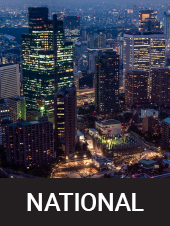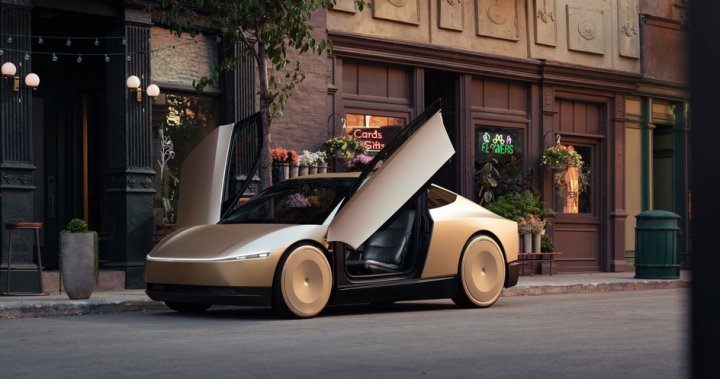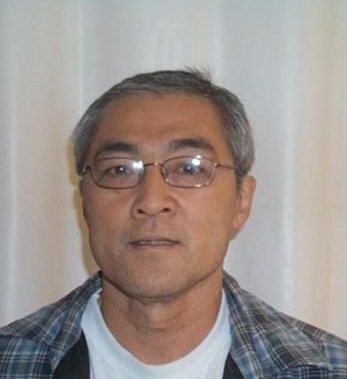On Thursday night, Tesla CEO Elon Musk set his sights on the future as his sleek, self-driving Cybercab drove through a staged city street at Warner Bros. Studios in Burbank, Calif. — but the flashy display wasn’t quite enough to truly woo investors.
The Cybercab, a robotaxi, is an autonomous, shiny, two-seater vehicle with double gull-wing doors and no steering wheel or pedals.
At Tesla’s invite-only “We, Robot” event, Musk estimated the consumer cost of a Tesla Cybercab would be about US$30,000 (C$41,250). The billionaire said the vehicle would “probably” be ready to purchase by 2027.
With the relatively low price tag, Musk said autonomous vehicles could be thought of as “individualized mass transit,” with a fuel cost of 20 U.S. cents a mile (12 U.S. cents a kilometre) over time.
The Cybercab’s charging will be inductive and does not require plugs, Musk advertised. (Inductive charging is wireless and uses electromagnetic induction to provide cordless electricity; for example, driving a car onto a charging station to fuel up.)
Tesla CEO Elon Musk on Oct. 10, 2024, unveiled the company’s new self-driving robotaxi, called Cybercab, which the billionaire said will be ready for consumer purchase by 2027 for about US$30,000 (C$41,250).
Tesla
Despite Musk’s ambitious promises and the positive reaction of the event crowd, investors’ reaction was lukewarm.
Tesla shares fell six per cent before the bell on Friday. The stock, which has been pummelled in recent years — much to do with fears of rival electric vehicle brands eating into Tesla’s market share — has bumped up nearly 50 per cent since April, when Musk announced the shift to robotaxis.
Still, Tesla shares are down eight per cent over the last year, compared with a 33 per cent increase in the broad-market S&P 500 index.
The inside of Tesla’s newly unveiled Cybercab, which Elon Musk claimed would be ready for purchase by 2027.
Tesla
Musk said the company has already produced 21 Cybercabs.
At Thursday’s big-budget event, he also unveiled Tesla’s new Robovan, a self-driving bus-like vehicle that can transport 20 people or a surplus of goods.
Tesla’s newly unveiled autonomous Robovan can transport up to 20 passengers, CEO Elon Musk advertised.
Tesla
Musk imagined the Robovan being used to “solve for high density” transport, like ferrying an entire sports team.

Get daily National news
Get the day’s top news, political, economic, and current affairs headlines, delivered to your inbox once a day.
He said the Robovan would also use inductive charging, but did not reveal when the vehicle would begin production, or how much one would cost.
“With autonomy, you get your time back,” Musk said.
He claimed his Cybercab would improve people’s lives by saving them time driving through traffic or looking for a parking spot.
“You can think of a car in the autonomous world being like a little lounge,” he said, adding that Tesla owners of the future could work, watch a movie or spend time on their phones, rather than drive attentively.
Beyond that, Musk boasted that self-driving cars would “save lives and prevent injuries.” He predicted autonomous vehicles would one day be 10 times safer than a human driver, but did not provide any additional information.
Musk did not specify where Tesla plans to produce its two new autonomous vehicle offerings.
He did, however, predict launching unsupervised full self-driving (FSD) in California and Texas in the company’s Model 3 and Model Y electric vehicles by next year. As of now, Tesla only offers a “supervised” version of FSD, which requires a human driver at the ready to steer or brake behind the wheel.
“You could fall asleep and wake up at your destination,” Musk said of full self-driving.
It is unclear if Tesla has already applied for or obtained proper permits to operate autonomous cars on public roads.
Beyond vehicles, Musk appeared excited to show off the company’s humanoid robots. A line of the robots, called Optimus, entered the event space on their own in a single-file line.
In an attempt to prove Optimus is not just a “canned video,” Musk told the crowd the Optimus robots, which served drinks during the event, will “walk among you.” He asked audience members to “be nice” to the robots.
Musk said Optimus could in the future be “something spectacular; something that anybody could own.”
He predicted an Optimus would one day cost “probably US$20,000 to $30,000, long term” (about C$27,500 to $41,250).
Tesla advertised Optimus as an “autonomous assistant” and “humanoid friend.”
“I think this will be the biggest product ever, of any kind,” Musk bragged.
Time will tell if Musk and Tesla are able to deliver on the ambitious promises made during Thursday’s flashy product launch. The company has in the past repeatedly missed deadlines set by Musk, including a 2015 claim that Tesla’s vehicle fleet would reach “full autonomy” within three years. In 2024, this is still not the case.
The Cybercab will be forced to compete with other autonomous vehicles, including the Alphabet-owned Waymo and other Chinese manufacturers. By pursuing a lower-cost technological path for Tesla’s self-driving vehicles, Musk believes the company will be able to scale up far quicker than rivals.
Tesla’s strategy is simpler and much cheaper than that of its rivals but has critical weaknesses. Chief among those is that the AI technology underpinning its self-driving system makes it nearly impossible to pinpoint why a crash or other failure occurred — something that could concern regulators.
Tesla’s rivals use similar AI and camera technology, but layer on so-called redundant systems and more expensive sensors as a safety precaution.
Shares of ride-hailing firms Uber and Lyft were up about four per cent in premarket action, in a sign that Musk’s announcements were not seen as a threat to the companies.
— With files from Reuters





